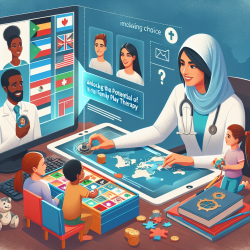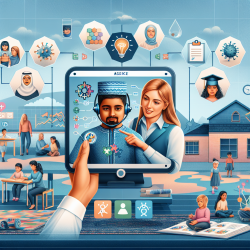Introduction
In the ever-evolving landscape of child therapy, leveraging data-driven insights is paramount to enhancing therapeutic outcomes. The recent systematic review titled "Methods Used in the Spatial and Spatiotemporal Analysis of COVID-19 Epidemiology" provides a wealth of information that can be harnessed to improve online therapy services, particularly in understanding and addressing the spatial dynamics of therapy needs and outcomes.
Understanding Spatial and Spatiotemporal Analysis
The study highlights the use of spatial and spatiotemporal analysis to understand the complex dynamics of COVID-19 spread, emphasizing the importance of identifying spatial clusters and risk factors. These methodologies are not only applicable to epidemiology but can also be translated into the realm of child therapy, where understanding spatial patterns can lead to more targeted and effective interventions.
Application in Child Therapy
For practitioners at TinyEYE, incorporating spatial analysis can offer several benefits:
- Identifying High-Need Areas: By mapping therapy needs and outcomes, practitioners can identify regions with higher demand or lower success rates, allowing for the allocation of resources where they are most needed.
- Tailoring Interventions: Understanding the spatial distribution of therapy outcomes can help tailor interventions to specific community needs, enhancing the effectiveness of therapy programs.
- Data-Driven Decisions: Utilizing Bayesian models, as suggested in the review, can provide a robust framework for making informed decisions based on spatial and temporal data, accounting for uncertainties and variations in therapy outcomes.
Encouraging Further Research
The review underscores the potential of Bayesian spatiotemporal models in providing nuanced insights into spatial dynamics. For practitioners, this presents an opportunity to delve deeper into research, exploring how these models can be adapted and applied to therapy settings. By engaging in further research, practitioners can contribute to the development of innovative solutions that address the unique challenges faced in online therapy.
Conclusion
Incorporating spatial and spatiotemporal analysis into child therapy practices offers a promising avenue for enhancing therapeutic outcomes. By leveraging data-driven insights, practitioners can make informed decisions that lead to more effective and targeted interventions, ultimately improving the lives of children. For those interested in exploring this further, the original research paper provides a comprehensive overview of the methodologies and findings that can be adapted to therapy settings.
To read the original research paper, please follow this link: Methods Used in the Spatial and Spatiotemporal Analysis of COVID-19 Epidemiology: A Systematic Review.










